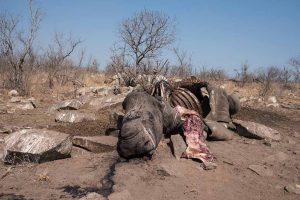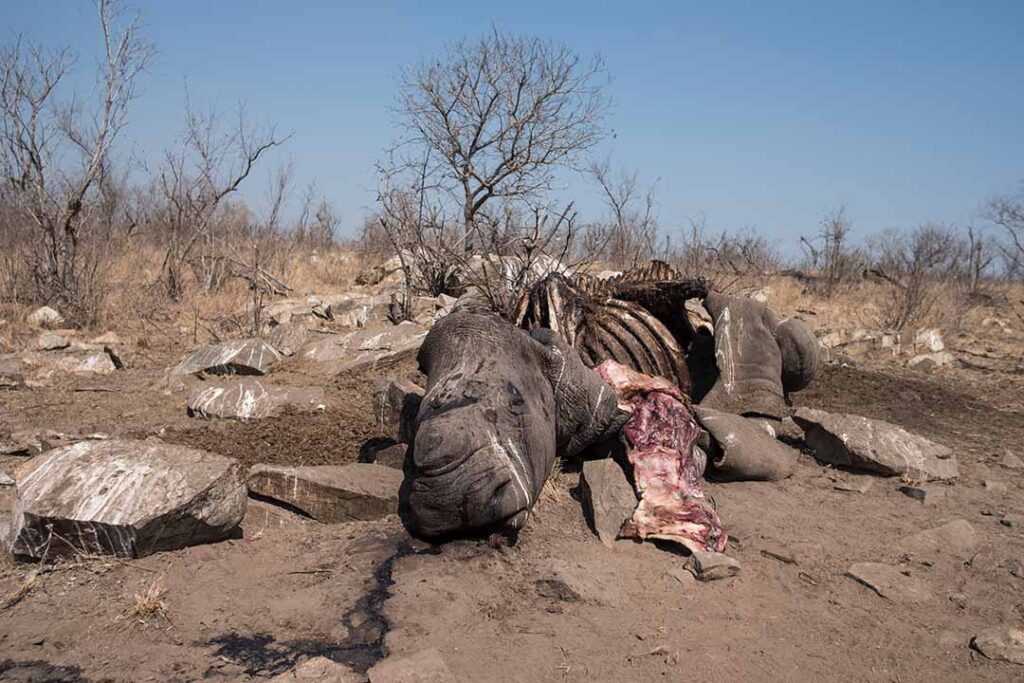Poaching: the big guns
South Africa’s game reserves have been hard hit by an intensive campaign of poaching and wildlife crime

The rampant increase in wildlife poaching has been widely acknowledged as one of the greatest threats to biodiversity conservation in Africa. The Asian demand for rhinoceros horn has seen a massive onslaught on the white rhino (Ceratotherium simum) and black rhino (Diceros bicornis) populations. Since 2008, there has been a gradual and then explosive growth in rhino poaching in South Africa and, to a lesser extent, Mozambique and Botswana. In South Africa, the Kruger National Park region and the game reserves of KwaZulu- Natal have been the hardest hit by an intensive campaign of poaching and wildlife crime. Links to transnational crime syndicates and corruption have surfaced rapidly. The challenge became highly charged between conservation NGO movements and state conservation agencies.
According to Save the Rhino, an NGO that monitors rhino poaching statistics, South Africa lost 1,000 rhino per year between 2013 and 2017. In contrast, official rhino poaching statistics for 2018 and 2019 have shown a marked decrease. The decrease may be due to several factors: more law enforcement and counter poaching effectiveness (especially in the Kruger National Park and adjoining private reserves), a depleted rhino population and the additional effort that poachers must now make to locate rhino.The Kruger National Park covers an area of 19,485 km2 in the provinces of Limpopo and Mpumalanga in north-eastern South Africa. It extends 360 km from north to south and 65 km from east to west. It is estimated that some 3.3 million people live within 50 km of the Kruger National Park’s western boundary, though this figure is based on the last South African population census in 2011.
This does not take into account the Mozambican population on the Kruger National Park’s eastern boundary, or the Zimbabwean population just north of the Crooks Corner border between the three countries. The bulk of the population is rural, in many cases poverty stricken and highly dependent on the environment for their well-being and daily survival. In comparison to protected areas in the European Union and North America, the Kruger National Park is a massive area to protect and manage. Furthermore, South African National Parks (SANParks), the agency delegated to manage the country’s national parks, must compete for budget allocation from the fiscus. Other priority areas such as primary law enforcement, basic education, public health and related needs often take precedence over conservation and the management of parks. SANParks supplements its fiscal grant by undertaking revenue-generating activities such as providing accommodation, food services, safaris, walking trails, bird-watching, historical site tours, specialist activities and more.
A key element of SANPark’s strategy is community development, which is focused on building strong relations with local communities and traditional leadership. This includes providing communities with access to protein sources from culling and related park operations and harvested thatch for home-building programmes. This approach must also be seen within the bigger question of land reform and access to resources that dominate much of the current discourse in South Africa. At present, the Kruger National Park has a field ranger complement of approximately 450 rangers and other specialised counter-poaching resources and capabilities. The field rangers have extensive paramilitary and wildlife law enforcement training as well as in depth field-craft skills focused on operating safely within a dangerous game environment. The Kruger National Park’s capabilities include aerial support (helicopters and fixed wing light aircraft), canine tracking units, environmental crime investigation specialists and a partnership with the stock-theft unit and the wildlife crime section of the South African Police Service (SAPS).
It now also has a multi-sensory detection system, known as the MEERKAT, funded by the Peace Parks Foundation, which helps to locate poacher groups and direct rapid-response ranger teams and tracking dogs. In addition, the park has tested shot detection technology that is able to triangulate shots fired, which may have had a deterrent effect on poacher tactics. In 2013, with poaching of its rhino population rising, the Kruger National Park recognised the need to change its strategy and adopted a more vigorous counter-poaching approach. SANParks appointed well-known retired army Major General, Johan Jooste, to lead efforts to upgrade and enhance the parks response. The approach was successful, and Kruger National Park and General Jooste were requested to expand their efforts and support provincial conservation agencies and increase the integration of private reserves and anti-poaching units.
There still is a great focus on integrating operations with police, private anti-poaching units, provincial anti-poaching services and SANParks. But the militarisation of anti-poaching efforts has also resulted in the development of a ministerial approved Rhino Laboratory plan for law enforcement that guides much of the work in protecting rhino. At present, the Kruger National Park estimates that there may be as many as seven to eight poaching incursions into the park every day. Poaching groups have a very specific modus operandi that has been refined over time. On-the-ground poachers coordinate with local couriers, supervisors and local bosses to share information and adapt tactics. Teams of three to four individuals enter the park, travelling light and on foot. Each member of the poaching group has a specific role: one is the axe man, another the gun-bearer and another the shooter. Rhino are thick-skinned animals, weighing several tonnes. They are highly resilient to physical attack by humans.
Taking down a rhino requires a heavy calibre bolt-action rifle in the .375 to .458 magnum range. Given that the aforementioned sensory systems and in-depth monitoring are likely to locate them, poachers have to ensure that the rhino is killed with one shot, two at most. Then they must quickly hack off its horn and rapidly exit the park. In many instances the poachers are in such a hurry to depart that they leave a rhino alive, not wanting to risk the additional shot to put it down. They leave horrifically injured animals and often orphaned calves alone to face the elements. Social media and other platforms have distributed brutal visuals of injured rhino. Poachers have also shown ingenuity in assembling homemade suppressors to try to reduce the sound of gunshots. In many cases, they modify the firearm and weld on suppressors. Generally, firearms seized in the private reserves tend to have their serial numbers filed off, but the majority of the rifles seized in the Kruger National Park still have their serial numbers.
Poaching syndicates are ever more aware of the Kruger National Park’s ability to trace firearms. This is also true of provincial conservation agencies such as Ezemvelo KZN Wildlife in KwaZulu-Natal and the Eastern Cape Parks and Tourism Agency in the Eastern Cape Province. What is clear is that each poaching group will require at least one firearm. Going on the lower estimate of seven incursions a day, that suggests as many as 2,555 illegal heavy calibre firearms in the park annually. Even half that number would be a high figure, given the power of these weapons. That would be equivalent to the number of weapons needed by two infantry battalions. Firearms are generally available in Africa, mainly self-loading carbines such as AK- 47s and R-series weapons. Self-loading carbines have been the mainstay of low intensity warfare, civil war and violent extremism. But they are of little benefit to poachers who target rhino and elephant who need heavy calibre, bolt-action “hunting” rifles. Suitable rifles are obtained in a number of ways.
Firstly, farm attacks in South Africa have led to a hidden network of gangs providing poaching syndicates with stolen firearms and ammunition either through direct sales, on a rental basis, or for a percentage of the poaching proceeds (though the latter needs further confirmation). These potent networks have likely overseen the movement of rifles across provincial boundaries and across national borders. Although South Africa has strong legislation addressing firearm licensing, training and management, there are concerns that the regulations are inconsistent and the implementation lacking. This enables the illegal trade in firearms. According to registered security service providers, many gun shops have not been inspected for several years. Secondly, corruption at police station level has seen the sale and rental of firearms directly to poachers out of station armouries and evidence lock-ups. Several private counter poaching companies in the region have noted that rifles seized in arrests are being used by other poaching groups.
The third source of firearms is Mozambique, via a murky set of firearm consignments and deals struck by two particular gun dealers. Rumours also point to the rental of firearms from white South African farmers to poachers and poaching syndicates. A tendency to racially profile poachers has ignored the fact that there are white players in the industry, including professional hunting outfits and even the rhino owners themselves. In an intensive investigation between 2015 and 2017, Kathi Lynn Austin of the Conflict Awareness Project undertook an investigation into the supply of small arms manufactured by the Czech company CZ Brno to Mozambique – specifically, how they were getting to the poachers to be used in poaching events. Austin’s investigation used the follow-the-guns methodology, and highlighted critical links between CZ Brno in the US and in the Czech Republic with the arms trade with Mozambique.
Portugal is used for the transhipment of the firearms; transnational criminal syndicates needed their frontline poachers to have access to rifles that are powerful enough to kill a rhino, so they enabled a dedicated arms pipeline from Europe to Africa. Between 2014 to 2018 the average proportion of CZ Brno firearms as a percentage of the total seized in the Kruger National Park was 22.18%. However, about 85% of all CZ Brno rifles seized in the Kruger National Park originated from the Mozambican arms trade. This is highly concerning, given that there are only two licensed gun dealers in Mozambique, although this in itself does not mean that either gun dealer is involved in illegal firearm sales. Historically, Mozambique does not have a culture of recreational or professional hunting, although this is changing with the establishment of new protected areas, Big Five tourism lodges and hunting concessions. Mozambique is trying to diversify its tourism industry from the traditional beach tourism to a focus on ecotourism.
With this diversification into Big Five reserves comes a need for high calibre rifles to protect guests on safaris. This will likely lead to a steady legal growth of rifle sales in Mozambique over time. South African national parks and law enforcement agencies have engaged with their Mozambican counterparts, but the Mozambican authorities appear to have done little or nothing as regards the CZ Brno imports and distribution by the “Rhino Rifle Syndicate”, as it might be called. Firearm import and export certificates from countries of origin, transhipment documentation and port clearance approvals are often tampered with. It is recommended that the Mozambican authorities take a stronger stance on firearm import controls. The sad state of affairs of firearms management at some South African police stations should sound an alarm to the SAPS, as well as policymakers. Inspections of station armouries and evidence lock-ups need to be accelerated and conducted on an ad hoc basis.
The private security industry regulatory authority in South Africa must also take stronger measures to review and inspect the armouries and stockpiles of private security companies. Clear insight into the possible complicity of some of these companies is needed. Most of the poachers are now coming from the western boundary of the Kruger National Park; an overall drop in Mozambican poaching is noticeable. Overall, it is clear that the SAPS lack capacity and resources to investigate the role of illegal firearms in poaching. The Kruger National Park’s mandate ends at its fences, and the need for effective law enforcement in the rural areas around countering poaching remains critical



